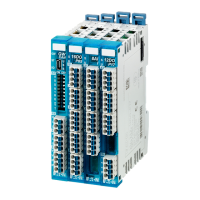34 DC motor driver module XN-322-1DCD-B35
34.3 Wiring topic
XN300 slice modules 02/24 MN050002EN Eaton.com 272
Relative or absolute counting
Tc (Time control), i.e., bit 11, defines whether the time value for the
subsequences will be counted as a relative or absolute value. It is possible to
use both counting methods at different points within the output sequence.
However, doing so is not recommended.
Bit 11 = 0: The pulse width is relative and is counted starting from the end of
the last sequence. The period always starts with sequence 1.
Bit 11 = 1: The pulse width is absolute and is counted starting when the
period begins. This means that the time specified for a sequence must be
longer than the time specified for the previous sequence.
Relative pulse width
Figure 148: Four subsequences with pulses when using relative counting
Absolute pulse width
Figure 149: Four subsequences with pulses when using absolute counting
Keep the ratio of the period duration to the sequence time in mind
a Subsequence 1, e.g. Motor off
b Subsequence 2, e.g. Operating direction right
c Subsequence 3, e.g. Motor off
d Subsequence 4, e.g. Armature short-circuit
a Subsequence 1, e.g. Motor off
b Subsequence 2, e.g. Operating direction right
c Subsequence 3, e.g. Motor off
d Subsequence 4, e.g. Armature short-circuit
NOTICE
Select period duration t
p
in line with the output sequence:
t
p
= t
OutputSequence =
t
OutputSequence1 +... +
t
OutputSequence4
Failure to do so may result in undesired XN300 slice module
states.
④③②①
t
P
A

